If you’ve ever wondered how your favorite fried chicken joint makes their food so good, I’m going to let you in on their little secret.
Cooking in professional kitchens, I learned quickly using the best oil to fry chicken makes all the difference. It may be the single most important factor to influence the flavor, texture, and health considerations of the dish.
Here’s the fact of the matter. You might already have the best recipe in the world for frying chicken wings or frying chicken cutlets, but if you use the wrong oil, you will probably be disappointed at the end. Fortunately, there’s an easy fix.
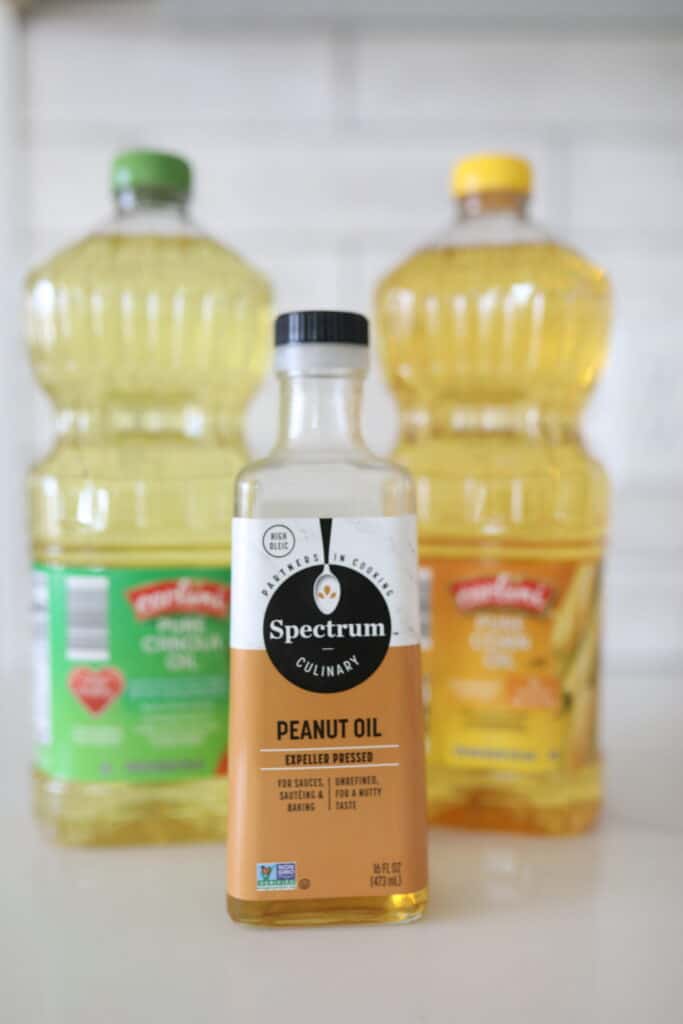
In this article, I’ll explain why you may be using the wrong oil, which oils to avoid, and how to pick an oil that will take your fried chicken to the next level. I’ll also provide 5 fried chicken tips to help you perfect your recipe.
Table of Contents
3 Best Oils For Frying Chicken
There are three primary factors to consider when choosing an oil to fry chicken:
- Smoke point – This is the temperature at which the oil begins to break down and smoke. A smoke point lower than 400°F (204°C) is too low to fry with.
- Flavor profile – Neutral flavor profiles are always a safe bet. Your dish is elevated when you find a complementary oil.
- Price – Always worthy of consideration. Particularly with frying because it requires a hefty amount of oil.
Below are my three picks that offer the best combination of the three factors above.
Peanut Oil
In my experience, peanut oil is the absolute best option for fried chicken. With a few caveats.
Peanut oil has a considerably high smoke point of 450°F (232°C) and a mild nutty flavor which works beautifully with chicken.
It also has minimal flavor transfer, meaning that your oil won’t transmit unwanted flavors from one meal to the next when reusing the oil. After all, you wouldn’t want a fishy piece of chicken if you fried catfish first.
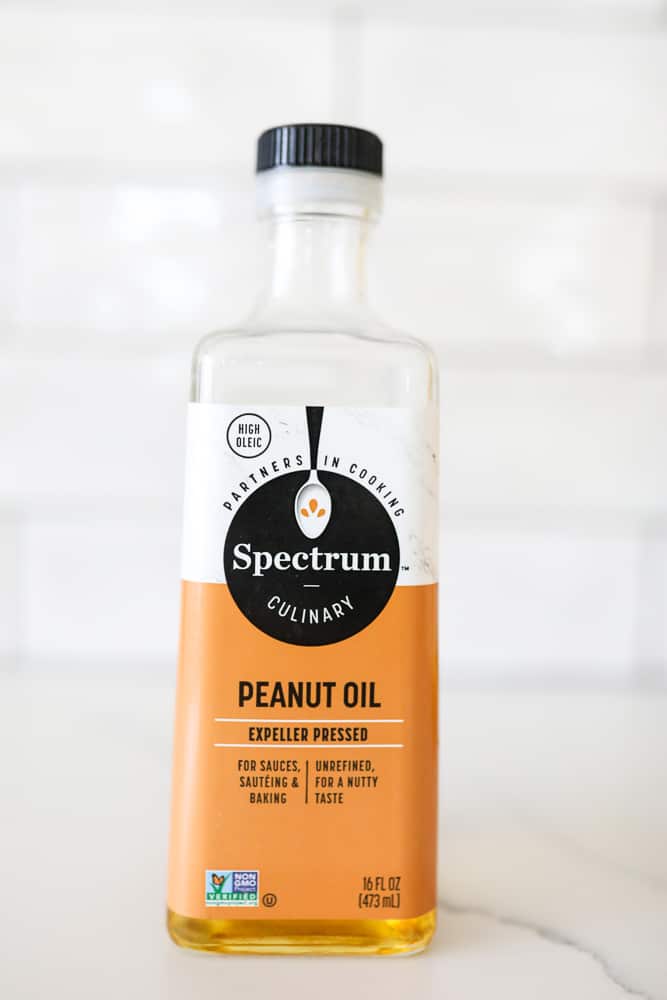
The primary drawback of peanut oil is that peanuts are a pervasive food allergen. Some people are gravely allergic, so survey your diners before using this oil.
The cost (~ $0.20 per fluid ounce) is slightly higher than other options. But I’d argue that the quality of peanut oil fried chicken more than makes up for the extra expense. Don’t forget to factor that peanut oil lends itself to reuse better than most oils.
Peanut oil is also low in saturated fats compared to many other cooking oils. And, a fun fact, Five Guys uses peanut oil exclusively for all their cooking.
Canola Oil
Canola oil is another great option for frying chicken.
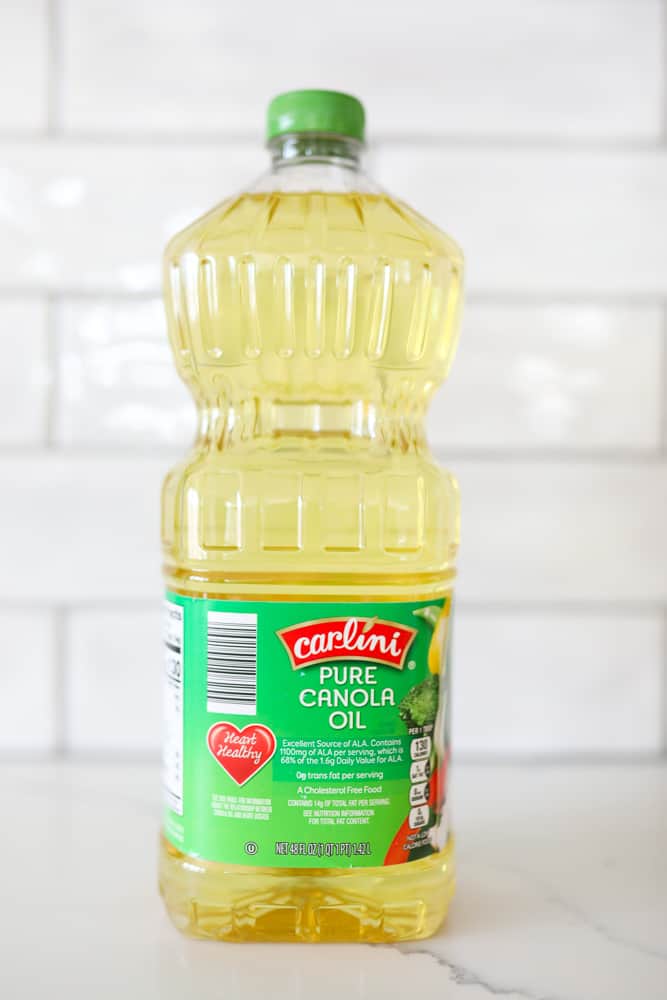
It’s the oil of choice for countless chains like Chick-fil-A and McDonald’s because it delivers great results for about half the price of peanut oil (~$0.11 per fluid ounce).
Canola oil has a neutral flavor and a high enough smoke point of 428°F (220°C). As a bonus, it is also rich in Omega-3 and Omega-6 fatty acids, making it a healthier option than most frying oils.
Corn Oil
Corn oil is the way to go if you want the crispiest fried chicken with a deep color.
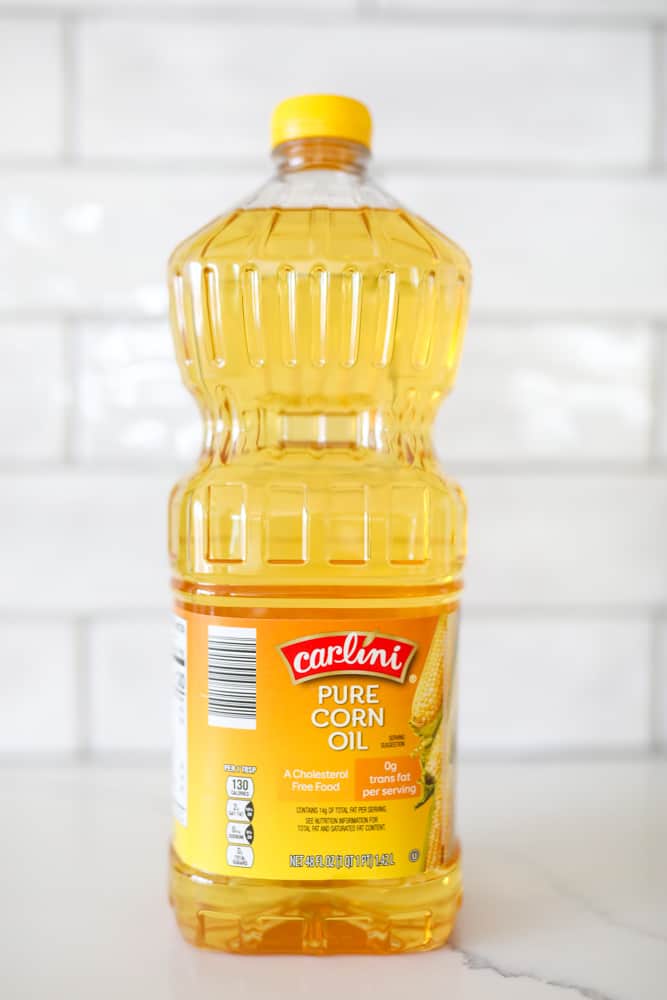
Like peanut oil, corn oil has a high smoke point of 450°F (232°C). It can withstand high temperatures without smoking up the whole kitchen. It has a relatively neutral flavor compared to peanut oil, but is more flavorful than canola oil.
Corn oil is low in saturated fats and high in Omega-3 fatty acids, making it a great option for preparing chicken cutlets or fried chicken. It is the cheapest option that I’d recommend, with an average cost of around $0.10 per fluid ounce.
Oils to Avoid to Fry Chicken
Avoid oils with a low smoke point, high density, high cost, or overpowering flavor for frying. Here are a few mistakes I’ve found many home chefs making. Do not use these oils for frying!
- Butter: The problem with butter is that it has a low smoke point of 350°F (177°C). Butter will split and burn when heated beyond this temperature since it is high in fat and calories. Purchasing good quality butter can be expensive, so I’d recommend you save it for baking, poaching, or sauteing.
- Coconut Oil: An expensive option that costs around $0.43 per fluid ounce, coconut oil is a saturated fat, which makes it high in density and rich in calories. With a low smoking point of 350°F (177°C), coconut oil also has a distinct flavor that tends to contradict the flavor profile of fried chicken.
- Extra Virgin Olive Oil (EVOO): There is always this constant buzz around extra virgin olive oil and how healthy it is. But is EVOO good for frying chicken? The answer is no. The smoke point of olive oil is relatively low at 320°F (160°C), making it easily burn or smoke. It also costs around $0.34 per fluid ounce, making it an expensive option for deep frying.
To recap, when frying chicken, avoid oil that:
- has a low smoke point
- is highly dense (not viscous)
- costs too much
Oil Summary Table – Smoke Point, Flavor, Price
| Oil | Smoke Point | Flavor | Price* |
| Avocado Oil (refined) | 520°F / 270°C | Neutral | ~$0.40/Fl oz |
| Sunflower Oil | 486°F / 252°C | Yes | ~$0.30/Fl oz |
| Light Olive Oil (refined) | 465°F / 240°C | Neutral | ~$0.31/Fl oz |
| Peanut Oil (refined) | 450°F / 232°C | Yes | ~$0.20/Fl oz |
| Sesame Oil | 450°F / 232°C | Neutral | ~$0.50/Fl oz |
| Corn Oil | 450°F / 232°C | Neutral | ~$0.10/Fl oz |
| Canola Oil (Rapeseed) | 428°F / 220°C | Neutral | ~$0.11/Fl oz |
| Vegetable Oil (refined) | 428°F / 220°C | Neutral | ~$0.10/Fl oz |
| Grapeseed Oil | 420°F / 216°C | Neutral | ~$0.22/Fl oz |
| Smoke Point Too Low to Fry: | |||
| Coconut Oil | 350°F / 177°C | Yes | ~$0.43/Fl oz |
| Butter | 350°F / 177°C | Yes | ~$0.27/Fl oz |
| Extra Virgin Olive Oil | 320°F / 160°C | Yes | ~$0.34/Fl oz |
For a more fulsome table including some fats, see 5 Best Oils for Searing Steak (+ 1 To Avoid).
If you’re looking for the best neutral oil to use depending on your cooking needs, read The Best Neutral Oil by Cooking Need.
5 Pro Tips for Frying Chicken
The secret to making oh-so-juicy pieces of fried chicken lies in what you do before and after it hits the oil. Here are 5 tips I learned as a professional chef that will help you nail fried chicken every time.
1. Sous Vide the Chicken Before Frying
Cooking the chicken sous vide before frying will guarantee perfectly juicy and evenly cooked fried chicken. Put the chicken and buttermilk in a vacuum seal bag and refrigerate for 2-24 hours. Then cook it at 150°F for about 3 hours before following your favorite fried chicken recipe. I promise it will be the dreamiest fried chicken you’ve ever tasted. You can thank me later!
2. Immediately Season Fried Chicken
Add salt as soon as you remove the chicken from the frying oil. Then let it rest on a wire rack for a few minutes before serving.
3. Pat and Dry the Chicken Before Breading
Use a paper towel to pat the chicken down before breading it to ensure a crispy exterior after frying it.
4. Add Cornstarch
Adding cornstarch to the all-purpose flour will make the texture of the fried chicken extra crispy and crunchy.
5. Steady Oil Temperature
While frying the chicken, make sure the oil’s temperature is between 300-350°F, at all times. This evenly cooks till the center and gives it a nice color. The smaller the batch being fried at one time, the easier it is to maintain the consistency of the temperature.
If frying chicken wings, use 375°F oil; The smaller fattier party wing pieces benefit from a higher temperature. The ideal temperature for chicken wings is higher than other parts of a chicken.
Stick to using oils like corn, canola, and peanut oil while making fried chicken. Stay away from butter, coconut oil, and olive oil.
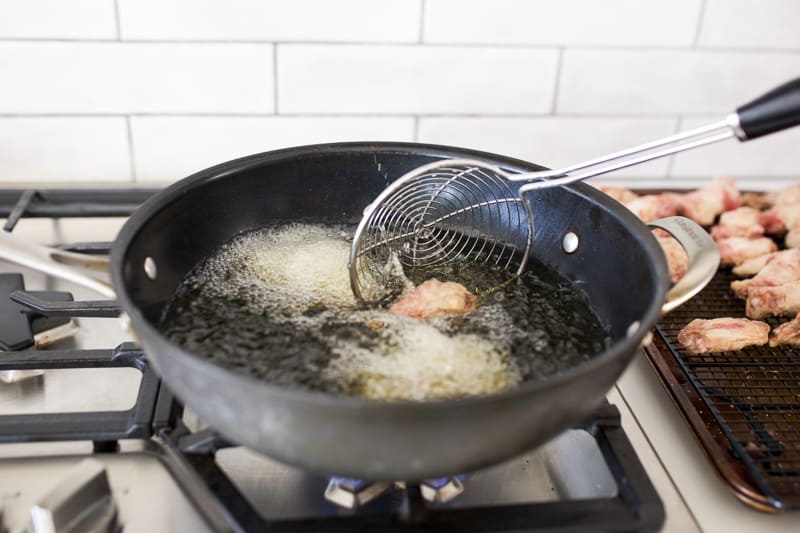
Did you know you can freeze fried chicken? Now you have an excuse to make a double batch.
Frying Chicken FAQs
Canola oil is a healthy option for frying chicken and other foods. It’s rich in Omega-3 and Omega-6 and low in saturated fats.
The tastiest oil for deep frying is peanut oil. Most oils used for deep frying are neutral in taste. But peanut oil has a nutty flavor that complements both savory and sweet dishes that are fried in it. The drawback is that it costs more than other options, and peanut allergies are common.
The secret to good fried chicken is starting with the right oil. Beyond that, there are several ways to optimize your recipe for best results. Use only the best quality meat, season it properly, start with sous vide before frying, and so forth. Perfecting your recipe can be a lifelong pursuit.
Peanut oil is the best oil to fry chicken wings, whether bone-in or boneless. The lightly nutty flavor compliments chicken wonderfully. Just be aware of allergies before using, as peanuts are a common allergen. Canola and corn oil are good cost conscious options too.

